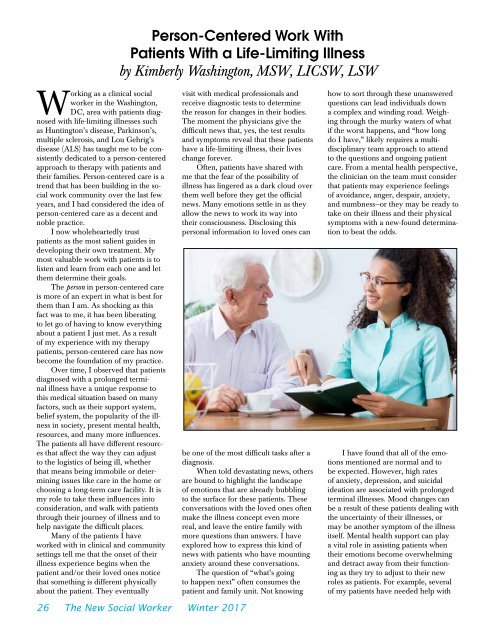In This Issue
click
click
You also want an ePaper? Increase the reach of your titles
YUMPU automatically turns print PDFs into web optimized ePapers that Google loves.
Person-Centered Work With<br />
Patients With a Life-Limiting Illness<br />
by Kimberly Washington, MSW, LICSW, LSW<br />
Working as a clinical social<br />
worker in the Washington,<br />
DC, area with patients diagnosed<br />
with life-limiting illnesses such<br />
as Huntington’s disease, Parkinson’s,<br />
multiple sclerosis, and Lou Gehrig’s<br />
disease (ALS) has taught me to be consistently<br />
dedicated to a person-centered<br />
approach to therapy with patients and<br />
their families. Person-centered care is a<br />
trend that has been building in the social<br />
work community over the last few<br />
years, and I had considered the idea of<br />
person-centered care as a decent and<br />
noble practice.<br />
I now wholeheartedly trust<br />
patients as the most salient guides in<br />
developing their own treatment. My<br />
most valuable work with patients is to<br />
listen and learn from each one and let<br />
them determine their goals.<br />
The person in person-centered care<br />
is more of an expert in what is best for<br />
them than I am. As shocking as this<br />
fact was to me, it has been liberating<br />
to let go of having to know everything<br />
about a patient I just met. As a result<br />
of my experience with my therapy<br />
patients, person-centered care has now<br />
become the foundation of my practice.<br />
Over time, I observed that patients<br />
diagnosed with a prolonged terminal<br />
illness have a unique response to<br />
this medical situation based on many<br />
factors, such as their support system,<br />
belief system, the popularity of the illness<br />
in society, present mental health,<br />
resources, and many more influences.<br />
The patients all have different resources<br />
that affect the way they can adjust<br />
to the logistics of being ill, whether<br />
that means being immobile or determining<br />
issues like care in the home or<br />
choosing a long-term care facility. It is<br />
my role to take these influences into<br />
consideration, and walk with patients<br />
through their journey of illness and to<br />
help navigate the difficult places.<br />
Many of the patients I have<br />
worked with in clinical and community<br />
settings tell me that the onset of their<br />
illness experience begins when the<br />
patient and/or their loved ones notice<br />
that something is different physically<br />
about the patient. They eventually<br />
26 The New Social Worker Winter 2017<br />
visit with medical professionals and<br />
receive diagnostic tests to determine<br />
the reason for changes in their bodies.<br />
The moment the physicians give the<br />
difficult news that, yes, the test results<br />
and symptoms reveal that these patients<br />
have a life-limiting illness, their lives<br />
change forever.<br />
Often, patients have shared with<br />
me that the fear of the possibility of<br />
illness has lingered as a dark cloud over<br />
them well before they get the official<br />
news. Many emotions settle in as they<br />
allow the news to work its way into<br />
their consciousness. Disclosing this<br />
personal information to loved ones can<br />
be one of the most difficult tasks after a<br />
diagnosis.<br />
When told devastating news, others<br />
are bound to highlight the landscape<br />
of emotions that are already bubbling<br />
to the surface for these patients. These<br />
conversations with the loved ones often<br />
make the illness concept even more<br />
real, and leave the entire family with<br />
more questions than answers. I have<br />
explored how to express this kind of<br />
news with patients who have mounting<br />
anxiety around these conversations.<br />
The question of “what’s going<br />
to happen next” often consumes the<br />
patient and family unit. Not knowing<br />
how to sort through these unanswered<br />
questions can lead individuals down<br />
a complex and winding road. Weighing<br />
through the murky waters of what<br />
if the worst happens, and “how long<br />
do I have,” likely requires a multidisciplinary<br />
team approach to attend<br />
to the questions and ongoing patient<br />
care. From a mental health perspective,<br />
the clinician on the team must consider<br />
that patients may experience feelings<br />
of avoidance, anger, despair, anxiety,<br />
and numbness—or they may be ready to<br />
take on their illness and their physical<br />
symptoms with a new-found determination<br />
to beat the odds.<br />
I have found that all of the emotions<br />
mentioned are normal and to<br />
be expected. However, high rates<br />
of anxiety, depression, and suicidal<br />
ideation are associated with prolonged<br />
terminal illnesses. Mood changes can<br />
be a result of these patients dealing with<br />
the uncertainty of their illnesses, or<br />
may be another symptom of the illness<br />
itself. Mental health support can play<br />
a vital role in assisting patients when<br />
their emotions become overwhelming<br />
and detract away from their functioning<br />
as they try to adjust to their new<br />
roles as patients. For example, several<br />
of my patients have needed help with




